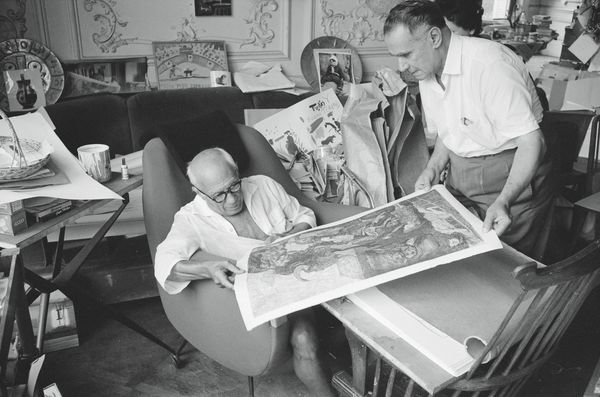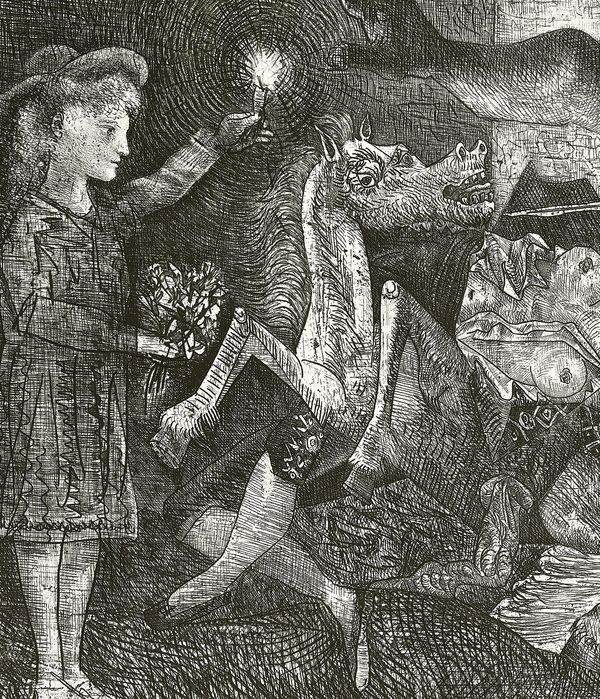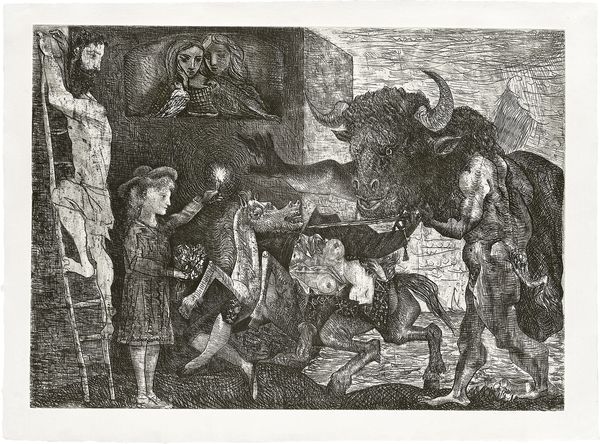Edward Quinn Picasso and Henri Matarasso, gallery owner and publisher, checking the etching 'La Minotauromachie', La Californie, Cannes, 1961. © edwardquinn.com © Succession Picasso/DACS, London 2019.
Hanging in the Musée Picasso in Paris, one will find Pablo Picasso’s original large scale copper plate, the origin of La Minotauromachie. In just over a month Picasso worked and reworked this plate, immersing himself in Roger Lacourière’s atelier, etching each detail of the image in an acid tank too small to contain the entire plate.
Dated March 23, 1935 in the plate, Lacourière printed the first state of La Minotauromachie only a few days after Picasso embarked on the endeavor. His invoices document a continuous collaborative process between artist and printer, progressively printing proofs of each state on a weekly basis, as Picasso’s plate evolved through its lifetime of seven total states: the 1st-2nd states printed from 25-29 March; 3rd-5th states from 1-5 April; 6th state from 8-12 April and the 7th (final) state 28 April-3 May.
Pablo Picasso La Minotauromachie (State I), 1935. © Succession Picasso/ DACS, London 2019.
The seven states show each stage at which Picasso reflected on his masterpiece in the making. The first state shows the basis of the composition; the second, the reworking of the building, the Minotaur’s right hand, and the female figures elaborated. The third state sees the first additions to detail in the brimmed hat, facial features, a remodeled man on the ladder, with the Minotaur’s arm thickened. For the fourth state, the artist reworked the entire plate, deeply incising the copper, resulting in a much darker, richer impression. The fifth state sees a lightness reintroduced to the composition in the sky, horse’s main and candle surround. The sixth state is modified by the Minotaur’s arm, with more light radiating from the candle, and the sky uniformly hatched. The seventh (final) state shows further work to the girls in the tower, the dove, and the hair of the girl holding the candle.
Pablo Picasso La Minotauromachie, 1935 (detail). Estimate: £800,000 - 1,200,000. Evening and Day Editions at Phillips London, 23 January.
Printing of the final state was completed by June 1936. Upon completion, and unlike his usual practice for graphic output, Picasso did not intend this particular print to be traditionally editioned, precisely organized or definitively numbered. Selling was not the priority. The image was of utmost importance to the artist - a decision clearly demonstrating his intense personal investment in the project. Instead, Picasso kept the entire group of prints for his own use, gifting more than half of them from 1935 through the 1960’s - signing, numbering and dedicating copies as they passed through his hands to the select few closest to him, and keeping them away from his most trusted dealers.
While no exact account of impressions exists, and there is no seeming rhyme or reason to the order of those few inconsistently numbered and gifted prints, numerous historians such as Brigitte Baer, and Sebastian and Herma Goeppert, alongside documents in the Musée Picasso and appearances of this image in the public marketplace combined, have identified the existence of between 55 and 65 examples of this final state impression.
Pablo Picasso La Minotauromachie, 1935. Estimate: £800,000 - 1,200,000. Evening and Day Editions at Phillips London, 23 January.
Nearly all of these recorded impressions of La Minotauromachie are now held in public or permanent collections, such as the Musée Picasso, Paris; Bibliothèque Nationale, Paris; Museo Picasso, Barcelona; Sprengel Museum, Hanover; Stedelijk Museum, Amsterdam; Ashmolean Museum, Oxford; The Metropolitan Art Museum, Tokyo; The Museum of Modern Art, New York; The Metropolitan Museum of Art, New York; The Brooklyn Museum, Brooklyn; The Art Institute of Chicago, Chicago; Museum of Fine Arts, Boston; The Philadelphia Museum of Art, Philadelphia; The Baltimore Museum, Baltimore; The Princeton Museum, Princeton; The National Gallery, Washington, D.C.; and The National Gallery, Ottawa; not to mention those in the most important private collections.
This work is new to the auction market. Purchased directly from Marina Picasso (Olga Khokhlova’s granddaughter), it is one of the group of unsigned impressions left to her after Picasso’s death and bears her collection inkstamp on the reverse.



